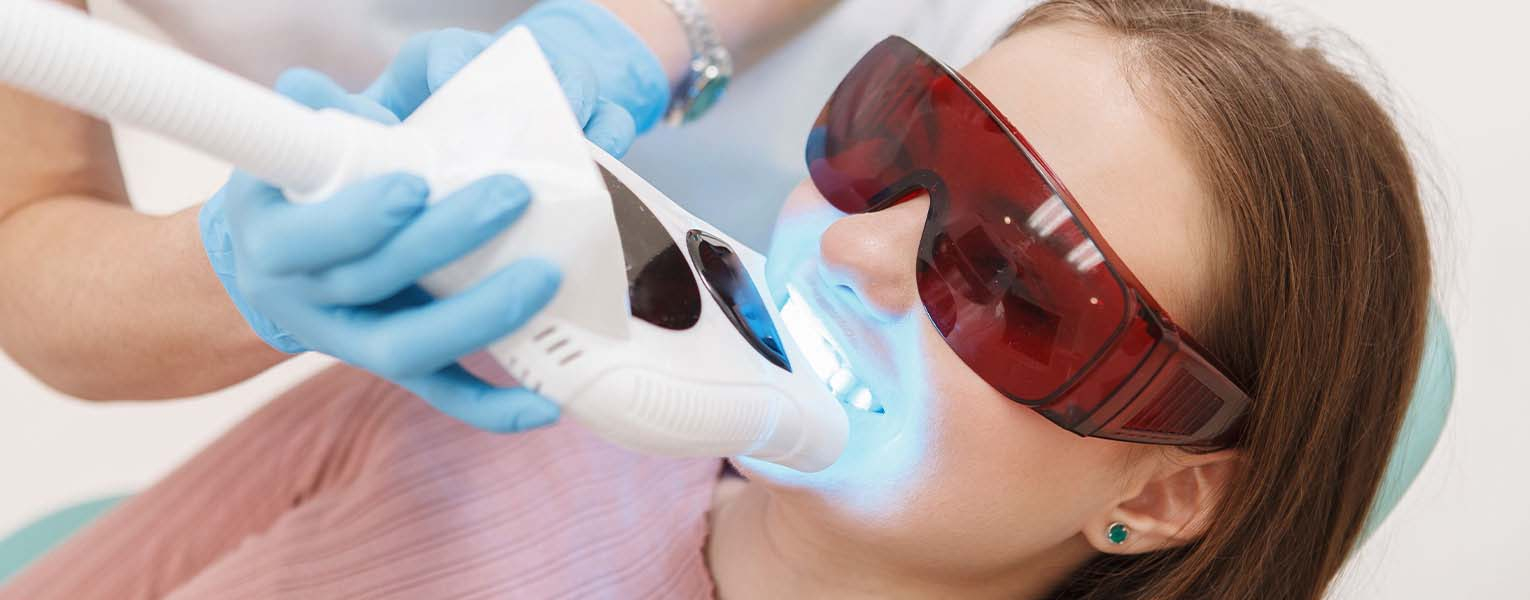How Many Different Types of Dental Bleaching Methods are There?
There are 4 different methods for teeth bleaching:
- At-Home Teeth Bleaching
- In-Office Teeth Bleaching (Bleaching at the clinic)
- Single Tooth Bleaching (Bleaching a tooth that underwent root canal treatment from the inside out)
- Combined Bleaching (Bleaching applied both at home and the clinic)
Which Method of Dental Bleaching Is the Most Suitable for Me?
If your teeth are already close to white in color and you want them to be a few shades lighter, laser or at-home whitening alone may be sufficient. However, if your teeth have become significantly darker due to smoking, coffee, or tea, the most suitable method will be determined after an examination. A clinical examination is required to decide on the most appropriate teeth whitening method for you.
How Is At - Home Dental Bleaching Done?
Personalized dental bleaching trays are prepared by taking an impression from inside the patient’s mouth. A certain amount of bleaching gel (10 to 15% carbamide peroxide or hydrogen peroxide) is applied to the trays.
How Long Does At-Home Dental Bleaching Take?
It is a treatment that takes 10 to 15 days if the trays are used for 4 to 6 hours during the day or 8 to 10 days if the trays are used at night while sleeping.
How Much Gel Should I Apply to the Trays?
For at-home teeth bleaching, it is very important not to apply bleaching gel to the trays more than indicated. Otherwise, the gel will overflow from the trays, irritating gums. In such a case, you should wash the gums immediately, apply the vitamin E to the irritated surface and contact the dentist.
What is In-Office Dental Bleaching?
This is a teeth whitening method performed within a dental clinic. It is a suitable option for patients with limited time. In some cases, the treatment duration may be shorter; the length of the procedure varies depending on the selected technique and the individual case. The whitening gel applied to the teeth by the dentist is activated using UV light or a laser, and the whitening process takes approximately one hour. It is also known as the “laser teeth whitening method.”
What is Combined Dental Bleaching?
In this method, at-home and in-office bleaching methods are applied in a combined fashion. After application at the office or clinic, the procedure is reinforced with at-home bleaching for 2 to 3 days.
What Should I Keep In Mind After Having My Dental Bleached?
Just as with other bleaching methods, after biological bleaching, especially in the first two weeks after the procedure, all colored drinks such as tea, coffee, and wine, soft drinks, such as coke, and tobacco products should be avoided. Otherwise, teeth may discolor early after the bleaching.
What is Single Dental Bleaching (Internal Bleaching)?
It is applied to teeth that discolor after root canal treatment. The filling in the tooth is removed, whitening gel is applied to that void, and then the tooth is covered with a temporary filling. The sessions are repeated at 3-day intervals until the desired color is achieved.
Does Internal Bleaching Damage a Tooth with Root Canal?
The biological teeth whitening method can be applied to individuals with tooth sensitivity. In whitening procedures, the substance that causes sensitivity is hydrogen peroxide. The effect of this method on sensitivity may vary depending on the individual and the initial condition.
Is There Any Harm or Any Side Effects From Dental Bleaching?
Bleaching may cause a little teeth sensitivity. This sensitivity may be to air, as well as to hot or cold food and drinks. This is a normal and expected side effect. The teeth sensitivity is expected to disappear within 24 to 48 hours. A physician should be consulted in case of an unexpected situation.
What Are the Causes of Teeth Discoloration?
- Lifelong physiological coloration
- Discoloration after amalgam filling
- Use of antibiotics in infancy
- Use of antibiotics during pregnancy
- Color change from inside the tooth due to root canal treatment
- Staining of tooth surface due to the consumption of coffee, tea, tobacco, red wine, and long-term mouthwash usage
- Discoloration because of bleeding inside the tooth due to tissue death, as a result of trauma
How Are Dental Bleached?
Dental bleaching is a process of removing the colored organic and inorganic substances formed in the porous enamel and dentin structures on the surface of the teeth using bleaching gels.
How Long Does It take for teeth bleaching to work?
It may vary from individual to individual. The average time for teeth bleaching is 2 to 3 weeks. Discoloration caused by the use of antibiotics is more difficult to eliminate and in such cases, it may take longer to achieve the desired result.
Do I Need to Clean Bleaching Trays?
Bleaching trays should be cleaned. After the trays are used, they should be washed with cold water and liquid soap, rinsed thoroughly, and kept in the provided tray box.
Is Teeth Bleaching Permanent?
After bleaching, teeth gradually discolor over time. Discoloration reoccurs in 6 months to 1 year depending on patient's frequency of consuming colored drinks (tea, coffee, wine, coke, etc.) and smoking. The bleaching becomes permanent when repeated every 4 to 6 months for 1 or 2 sessions.
What Should I Keep In Mind While Having My Dental Bleached?
During and for 2 days after bleaching, colored liquids such as tea, coffee, wine, and coke, as well as tobacco products, should definitely be avoided. Otherwise, the process will have an adverse effect and the teeth will be further discolored.
Does Bleaching Damage the Teeth?
As long as it is performed by a dentist, teeth bleaching is completely harmless for the teeth.
What Is Laser Bleaching?
The laser bleaching method is used to activate the bleaching agent applied to the enamel surfaces and to shorten the duration of the procedure.
The Author of the Article: Dt. Kerem Adalet
